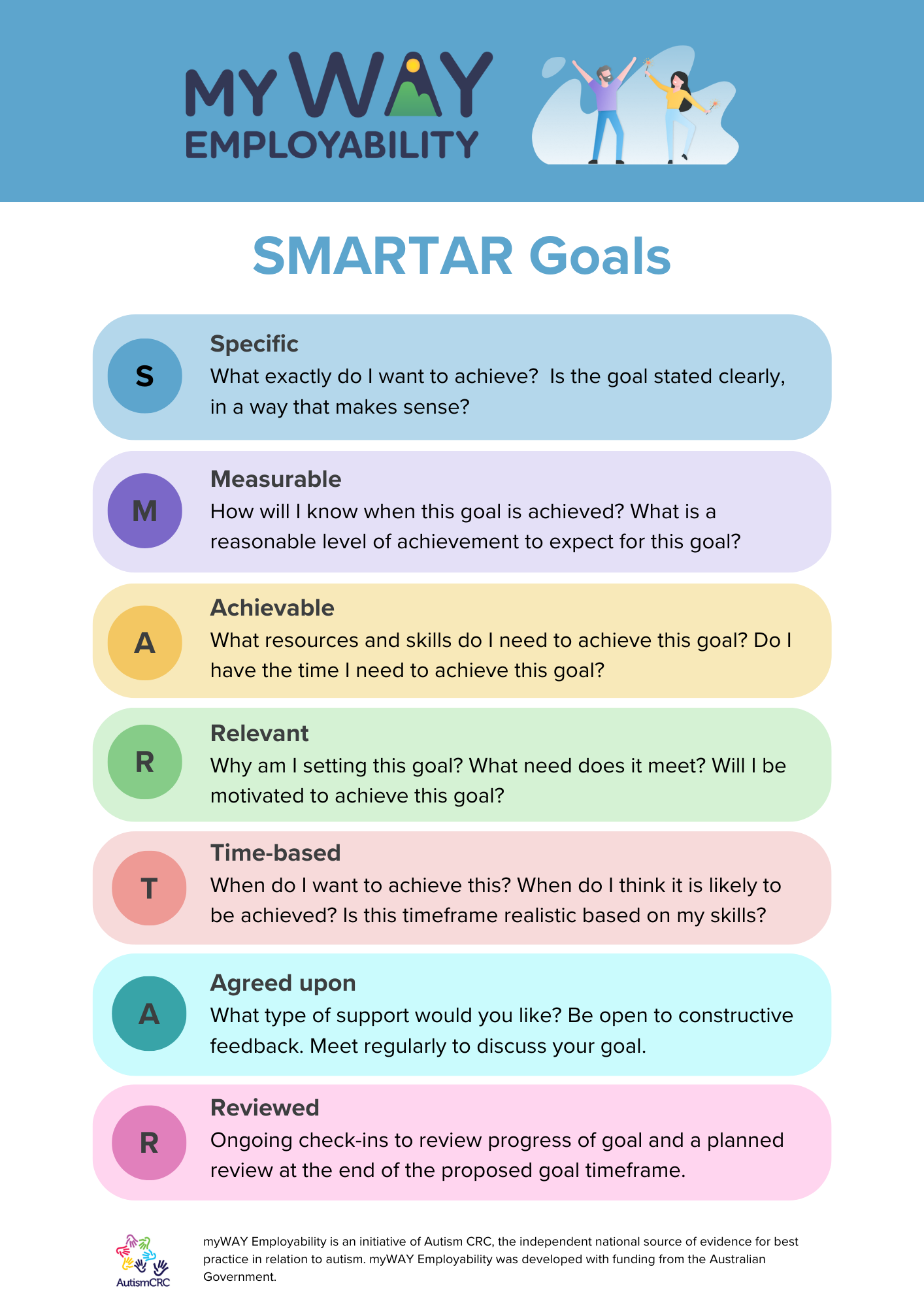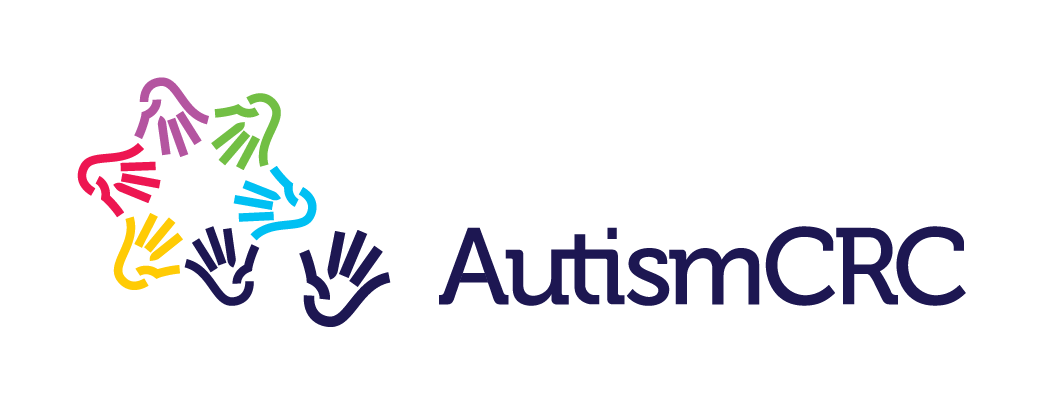Goal setting basics

Key Points:
- Goal setting is a way to achieve academic success and personal growth.
- Identify what you want, plan steps to get there, and track progress.
- Benefits of SMART goals: Boost motivation, self-regulation, and self-efficacy.
Most people know the SMART goal framework, but did you know there is an extended version called SMARTAR goals?
- S = Specific
- M = Measurable
- A = Achievable
- R = Relevant
- T = Time-based
- A = Agreed upon
- R = Reviewed
Having the additional sections Agreed upon and Reviewed means you can keep yourself and others accountable during the goal setting process. Your myWAY Supporter can help!
 |
Download the SMARTAR Goals handout |
Why SMARTAR goals?
- Keeps you accountable.
- Helps you focus on what you want to achieve and why.
- Helps break down big tasks.
- Allows adjustments as needed.
- Celebrate achievements and learn from failures.
- Develop a growth mindset and positive attitude towards learning.
Now we will take you through the SMARTAR goal framework so you can see how to make your own.
S = Specific
To be able to achieve a goal it must be specific. You have to be able to clearly define what you want to achieve and what that looks like.
Consider:
- What exactly do I want to achieve?
- Where do I want this to work?
- Who is involved?
- Is the goal stated clearly, in a way that makes sense?
S = Specific might include phrases that define:
- what the skill is
- the context it will be practiced in
- how you will demonstrate the skill or action
- the support that will be provided
M = Measurable
To be able to achieve a goal, it must be measurable. If you cannot measure it, then you won’t know how you are progressing. This also includes something to help you determine the success of a goal.
Consider:
- How will I know when this goal is achieved?
- What is a reasonable level of achievement to expect for this goal?
- How will I measure the goal in practice?
- What resources (e.g. extra time, another adult, checklist) will I need to measure the progress for this goal?
M = Measurable might include phrases that define quantifiable indicators or actions:
- How much?
- How often?
- How many?
- These can be numbers, percentages, dates or milestones.
A = Achievable
Goals must be attainable based on the resources, skills and time you have. Thinking about how achievable a goal is will help you in developing a goal. It is about finding your stretch zone.
Consider:
- What do I know about my current skills that will help me decide if this goal is achievable?
- Do I have all the prerequisite skills to complete this next step?
- What resources and skills do I need to achieve this goal?
- Do I have the time I need to achieve this goal?
- Who can I ask for help if I’m unsure if this goal is achievable?
A = Achievable might include phrases that define parameters for skill development including:
- Breaking down a task into small steps
- Learning pre-requisite skills first
- Getting support and reducing over time
- Planning for opportunities to practice the skill
R = Relevant
Goals must be relevant to your preferences, priorities, needs for development and skill progression. You are more likely to work towards, and achieve success with, goals that are meaningful to you.
Consider:
- Why am I setting this goal?
- What need does it meet?
- How does it increase my educational skill attainment, learning, or social/emotional development?
- Will I be motivated to achieve this goal?
R = Relevant might include ensuring the goal is aligned with:
- your interests, preferences and priorities
- your broader life context
- your long-term aims
T = Time-based
Setting a deadline in the form of a start or finish date can increase your focus and motivation to complete the goal. You can determine a realistic timeframe by thinking about your students’ abilities and your own needs and constraints.
Consider:
- When do I want to achieve this?
- How much time will I have to commit to this goal?
- How much opportunity will I have to work towards this goal?
- When do I think it is likely to be achieved?
- Is this timeframe realistic based on my skills?
Be aware of the timeliness of your goal – if it can’t be achieved within three months, it is too far removed from your daily activities to be effective. Break into smaller goals with closer timeframes, if necessary.
T = Time-based might include phrases that define:
- How long the goal will take to achieve
- When you will practice or work towards the goal
A = Agreed upon
Speaking with someone about your goal can help you tweak it to be more successful, but it can be daunting to discuss your goal with another person.
Consider:
- Making it clear what type of support you would like from this person.
- Being open to constructive feedback about your goal.
- Establishing ongoing times to meet to discuss your goal.
A = Agreed upon might include:
- Your family
- Your friends
- Your myWAY Supporter
- Allied health professionals to provide expertise in specific skill areas
- Anyone who may have information about your skills and preferences
R = Reviewed
Goals should be reviewed after the proposed timeframe to determine their effectiveness. However, this review stage should be flexible, in case you meet the goal sooner than expected, or if the strategy is clearly not working.
Consider:
- How will you collect information to inform the review? Go back to the ‘measurable’ step of your goal setting, if needed.
- Who should be involved in the review process?
R = Reviewed might include:
- Ongoing or short-term monitoring to check whether progress is occurring
- Flexibility to adjust the goal or the supports if progress is occurring faster or slower than anticipated
- A planned review process at the end of the proposed timeframe
- A longer-term plan for your learning, to guide the next steps after the current goal is achieved
Example SMARTAR goals
Here are some examples of SMART/AR goals. Note that the Specific, Measurable, Achievable, Relevant, Time-based, Agreed upon, and Reviewed sections don’t necessarily go in order, nor are they always involved in every goal.
"I will attend one (Measurable) free online webinar (Specific) per term (Time-based) to increase my knowledge (Achievable) of coding and software design (Relevant), and share my learning with my Supporter (Reviewed)."
"I will take the train to work (Specific, Relevant) once per week (Time-based), increasing to 2-3 times per week in one month (Measurable) – if I become anxious I can ask Dad for a lift (Achievable, Agreed upon)."
"I will start saving for a car (Specific, Relevant) by putting aside 10% of my allowance/pay per week (Time-based), increasing to 20% in three months (Measurable, Achievable)."
Assess your SMARTAR goal
To assess the effectiveness of your SMARTAR goals, you can:
- Share your goal: Share your goal with others to have a support system in place.
- Set check-in reminders: Ensure that your goal remains top of mind.
- Write it down: This makes your goal more tangible and easier to track.
- Adjust deadlines as needed: Be flexible and realistic with your timeframes.
- Develop specific tasks to track: Break down your goal into smaller, manageable tasks.
- Remember, the key to achieving goals is to make them as clear and actionable as possible.
 |
Download the SMARTAR Goals handout |

